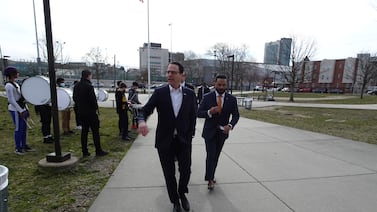Sign up for Chalkbeat Newark’s free newsletter to keep up with the city’s public school system.
Latinx students in New Jersey make up over a third of the public school population but face educational inequities such as less access to school counselors, disparities in academic performance, and low college enrollment rates, a new study found.
Addressing the needs of these students is “an urgent matter,” said Dr. Vandeen Campbell, co-author of the report and associate director and assistant research professor at the Cornwall Center.
“This report couldn’t be more timely because it gave us the opportunity to zoom in and start thinking about solutions for the Latinx population,” Campbell added.
The report, “The Latinx Experience in NJ Schools: A Preliminary Overview,” released last week by the Latino Action Network Foundation and the Joseph C. Cornwall Center at Rutgers University, shows that the state’s Latinx student population is steadily increasing, with those students attending schools where they are less likely to be around students from different backgrounds and less likely to have access to advanced courses and basic resources like mental health professionals.
Latinx students are attending “increasingly hyper-segregated schools” and those schools are more likely to experience higher levels of poverty, the study found.
Latino Action Network, the policy arm of the foundation that co-commissioned this report, is also advocating for solutions through a legal route. The organization is part of the coalition of plaintiffs in a lawsuit against New Jersey, currently before a state Superior Court judge, that argues the state needs to fix its heavily segregated public school education system. That case has been on pause for six months as plaintiffs — who also include the state chapter of the NAACP, families, and other advocates — continue to engage in mediation discussions with state officials.
The report comes as Newark, the state’s largest school district, sees a steady increase in Latino students and expects more than 11,000 English language learners to enter the district next school year.
According to the report, the percentage of schools enrolling more than 75% Latinx students has gone up from 5% in the 2013-14 school year to 8% in 2022-23. Of those schools, on average, 77% of students enrolled received free and reduced-priced lunch, which low-income children are eligible for.
Compared to other racial groups, Latinx students have one of the lowest graduation rates at 85%, six percentage points below the statewide average of 91%. In Newark Public Schools, that rate is 83%, a data analysis component of the report showed. The state’s Latinx students are also graduating high school at a rate equal to the national average for public school students, but enrolling in college at a rate lower than the statewide average, the report found. Those trends point to barriers in the college admissions process and the student-to-guidance counselors ratio in public schools, co-authors of the report said.
During the 2019-20 school year, on average, a counselor in a heavily Latinx school was advising 166 more students than in a typical school, the report found. The statewide ratio of students to counselors has improved since and is now at 339 students per counselor and 491 students per counselor in heavily Latinx schools, according to the report. But those numbers represent a disparity with counselors in Latinx schools advising about 152 more students than the typical school in the state, according to the report.
“If this is their first time going to college, they need the infrastructure to help them complete applications and find funding to apply,” said Swati Dontamsetti, a co-author of the report and doctoral candidate at Rutgers-New Brunswick.
The higher the percentage of Latinx students in a school, the more English language learners in its student body, the report found. Dr. Claudia Castillo-Lavergne, a co-author of the report and post-doctoral associate at the Cornwall Center said it’s important to understand the needs of these students who are a subgroup within the Latinx population in schools.
In the last decade, the overall percentage of English language learners increased by around 5 percentage points, from 4% of the state in the 2013–14 school year to 9% in 2022–23, according to the report.
“There’s certainly a greater need, I think, for supporting and understanding how they’re learning,” Castillo-Lavergne said. “How do we think about cultural responsiveness in connection to what they already know?”
Despite sobering trends, the study also found positive outliers in student achievement and enrollment in career and technical education courses. The co-authors of the report say those outliers are important to learn from to improve the trajectory of students. In career and technical education, Latinx students seem to enroll at higher rates than other student groups, the report found.
Additionally, recent data from the National Assessment of Educational Progress, and the state’s learning assessments show that the pandemic wiped out academic progress made over the previous decade, the report says. But Latinx students in 36 districts closely met or outperformed the 2021-22 school year state average in English language arts proficiency, while 23 districts had these students performing better than the state average in math, the report found.
“I think this is really connected to our future workforce and that question of how exactly do we expect these families to come out of poverty and integrate into society if the systems are set up against them?” said Dr. Jesselly De La Cruz, executive director of the Latino Action Network Foundation.
The report is meant to inform policymakers about the state of Latinx students in New Jersey’s public schools and help create better policies to support them, report co-authors say. They will also hold an event on Saturday, May 11 at Rutgers-Newark to discuss their findings and possible solutions.
Jessie Gómez is a reporter for Chalkbeat Newark, covering public education in the city. Contact Jessie at jgomez@chalkbeat.org.







